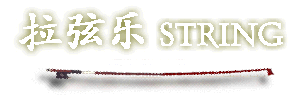
Web Composer: 

City Chinese Orchestra
![]()
Wong Chin Loon
E-mail:
chinloon@pacific.net.sg
Updated:
28 Jun 1997
Feedback, comments
and suggestions
are welcomed.

 Erhu was developed from the Hu Qin Family. It plays an important role in Solos, Chinese Orchestra, and Chinese Opera.
Erhu was developed from the Hu Qin Family. It plays an important role in Solos, Chinese Orchestra, and Chinese Opera.
In the past, Erhu was used by priest and street artist, who had low social status. To increase its status, the famous Musician Liu Tian Hua (1895~1932) put in a lot of effort to learn the art of Erhu, and at the same time with the knowledge of Western String Instruments such as Violin, he improvised on the techniques in performing Erhu. As a result, Erhu was able to be performed on stage and became a discipline in the College Of Music. He wrote the syllabus for training Erhuist systematically, which became a solid foundation for subsequent developments. Famous Solos pieces written are "Bing Zhong Yin", "Liang Xiao", "Kong Shan Niao Yu", "Guang Ming Xing", etc.
Another famous Erhu Soloist Hua Yan Jun (1893~1950), nickname Ah Bing, made Erhu, which was previously used to accompany Chinese Opera, a Solo instrument. He learned from his father, a priest, Erhu and Pipa. In his mid-life, he became blind, and was well know as "The Blind Man Ah Bing". He led a pathetic life and earned his livings through playing solos on the streets. His talent was later discovered in his late years when he was invited to perform on stage but before he was able to enjoy his new found status, he died in 1950. Famous Solos pieces performed are "Ting Song", and "Er Quan Ying Yue".
The structure of Erhu consisted of two strings tuned to a perfect fifth interval (D, A) and a bow hair in between. When the string is vibrated, the snake skin of the wooden drum that was placed on the lap is vibrated also. A very soft sound will be produced and if listened carefully, it sounds like a human voice humming. The absence of fingering board allows Erhuist to freely manipulate the tension of the strings to produce a wide variety of musical effects, such as the famous sound of horse galloping and neighing.